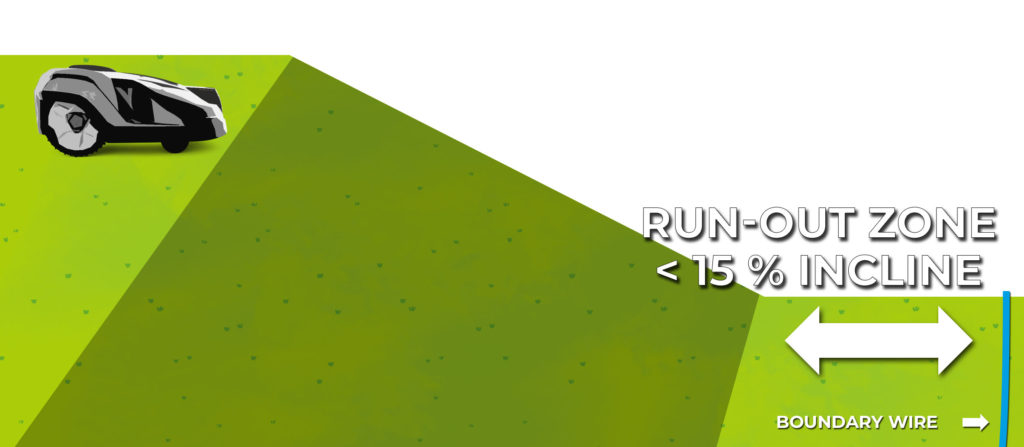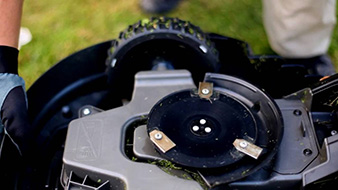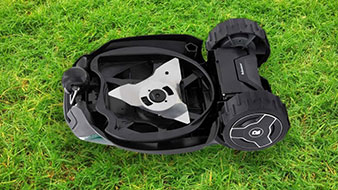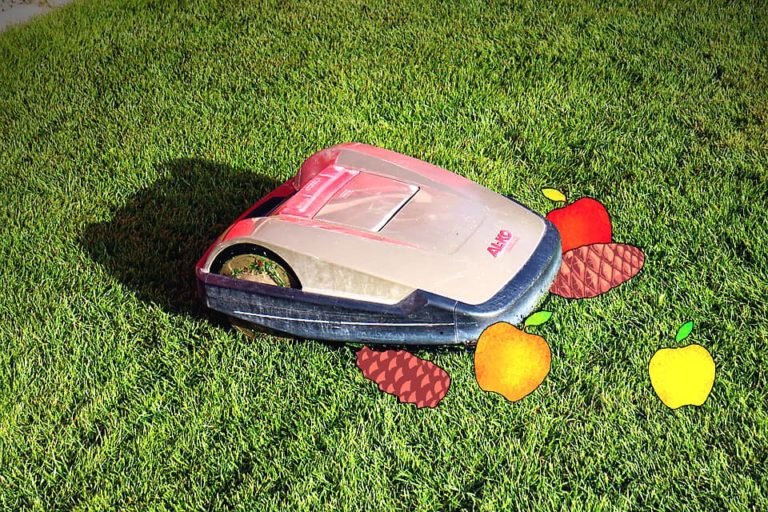Before you buy a robotic mower, you want to be sure that such a device will be beneficial for you and will not cause more problems than it solves. Surely you have already given some thought to the problems it might cause.
But some potential problems are not immediately obvious if you are not already deeply involved in the topic. That’s why I would like to introduce you to a few potential problems with robotic mowers that a robotic mower novice might not be able to solve directly.
For many of these problems there are also solutions. For some of them it is crucial that you buy the right robotic mower for your situation.
These are problems that are not necessarily immediately clear to many robotic mower newbies:
- Robotic mowers can damage the lawn in wet conditions and on steep slopes
- Fallen branches, pinecones, fruit, leaves, and nuts are a problem for some robotic mowers
- Underground garages can disturb the navigation of your robotic mower
- Many robotic mowers do not mow all the way to the edge of the lawn
- Robotic mowers can get stuck in problematic places
- Robotic mowers have navigation problems in narrow passages
- Breakage of the boundary wire – not a rare problem
- Some lawns are too long and narrow to be mowed with a robotic mower
- There may be problems entering or finding the charging station
- Conflicts between neighboring robotic mowers
- Robotic mowers are a danger for rabbits and other small animals
Contents
1. Robotic Mowers Can Damage the Lawn in Wet Conditions and on Steep Slopes
Under certain circumstances the wheels of your robotic mower can spin fruitlessly, or the robotic mower may slip. This can damage the lawn.
There are several situations where this can happen:
- You have a very steep hill, which the robotic mower cannot handle
- You have a steep slope which the robotic mower cannot manage in wet conditions, because it slips
- Your robotic mower is very heavy and leaves wheel grooves in the muddy ground
Case A: Slope is Too Steep
Each robotic mower is designed for a specific maximum gradient. This is always stated in the specifications. Most devices easily manage 25%. There are also many that can handle 35%.
Many HUSQVARNA machines can tackle as much as a 45% gradient, according to the manufacturer. There is even a device from this manufacturer that achieves 70%.
When buying your robotic mower, you should therefore make sure that it is designed for the maximum gradient of your lawn. Here I explain how you can calculate the gradient in your lawn.
An important tip: For most robotic mowers, the information about the maximum gradient does not apply to the area leading up to the boundary wire. Since the robotic mower can only be controlled while inside the boundary wire, and therefore will turn when it meets it, a gradient leading up to the wire can cause problems. The robotic mower needs a run-out zone, where it can recover from the momentum of a downhill slope and avoid overrunning the boundary wire.

Read here how to find the right robotic mower for slopes.
Case B: Slopes in Wet Conditions
It is possible that your robotic mower is designed for the slopes in your lawn, but it may slip on the slope when it is wet. This creates really unsightly holes in the lawn.
If your lawn has a steeper incline, I would therefore recommend that you buy a robotic mower with a rain sensor. This allows you to set the robotic mower so that it does not mow when it rains.
Another solution to the problem is the use of lawn protection nettings. These are mesh-like nettings made of plastic that you can lay on the lawn. The lawn grows over them in time and they become hardly visible.
These nettings are great for preventing damage caused by the robotic mower slipping. I have found an example on Amazon:
Here you can read more about when a robotic mower should have a rain sensor.
Case C: Heavy Robotic Mower Leaves Grooves
Nowadays this is only true for robotic mowers meant for large areas, because they are of course a bit bigger and heavier. However, it also depends on the battery used. Some robotic mowers use older battery types, which are significantly heavier than the modern lithium-ion batteries.
Particularly heavy robotic mowers can leave grooves in the ground when it rains, especially if it has been raining for a long time and the ground has softened as a result.
Areas that it passes over particularly frequently, such as the area directly in front of the charging station or in bottlenecks, are especially prone to developing these grooves.
In these places you can of course also use the aforementioned lawn nettings from Case B, or simply lay concrete slabs.
2. Fallen Branches, Fruit, Pinecones, Leaves and Nuts Are a Problem for Some Robotic Mowers
Do you have fruit trees in your lawn? Or maybe pine trees that shed their cones, or black walnut trees dropping their massive walnuts? Or do you just generally have many trees in your lawn that often lose branches and shed a lot of leaves?
Then you should think carefully about which robotic mower you are going to buy, because the robotic mower does not usually stop when it encounters these things (an “apple guard” sometimes provides a remedy).
Some robotic mowers can handle leaves, apples, etc. quite well, while others have problems. This is due to the different mowing units they can have.
In general you can distinguish between two types of construction on a robotic mower:
- Mowers with blade plates and small swinging blades
- Mowers with a star cross


3. Underground Car Garages Can Disturb the Navigation of Your Robotic Mower
Yes, you read that right. If you have an underground garage for your car (not to be confused with underground garages for robotic mowers), this can lead to problems with your robotic mower.
This applies to robotic mowers with boundary wires, which make up the vast majority of the models on the market. And this only applies if the underground garage is located below your lawn.
Let me explain briefly why this is so:
- For robotic mowers with boundary wire, that wire runs around the mowing area. A weak current runs through the cable, which generates an electromagnetic field.
- This field in turn is measured by the robotic mower with special sensors. This enables it to know where the mowing area ends. However, it must always be able to measure the field, even if it is in the middle of your lawn.
- This is for safety reasons, because this is the only way your robotic mower knows that electricity is flowing through the cable at all and not that the power has failed. As soon as it can no longer register the magnetic field, it stops, with an error message (e.g. “outside the mowing area”).
Here you can read more about how the boundary wire works exactly on the robotic mower.
Underground garages now mostly use reinforced concrete ceilings. This reinforced concrete disturbs the magnetic field. So if the underground garage runs right under your lawn, it can happen that the robotic mower no longer measures the field and comes to a halt as described above.
Fortunately, there are various solutions for this. For example, you can lay additional loops with the boundary wire through your lawn to bridge such “transmission gaps”. It has probably worked for some users to lay the boundary wire twice to increase the field strength. Robotic mowers without boundary wire may also provide a solution.
I have described all of this and many other possible solutions in this article.
4. Remaining Grass Strip – Many Robotic Mowers Do Not Mow Completely to the Edge
When buying a robotic mower, many people dream of not having to deal with mowing their lawn at all. Unfortunately, this is not always the case, because many robotic mowers cannot mow right to the edge.
This is due to the fact that there is a safety distance between the mower deck and the outer bodywork which is much greater than it is on conventional lawnmowers.
The result is that on the outside of the lawn there is always an edge that you have to mow yourself.
However, there are several solutions to this problem:
- A robotic mower with an edge mowing function
- Laying lawn edging stones, so that the robotic mower can drive over the edge
- Quick weekly mowing of the edge with a lawn trimmer
Some manufacturers advertise that their models have an edge mowing function. Other names for this are edge mode, edge mowing or “Cut to Edge” (WORX).
Here I have compiled an overview of different models that mow to the edge, where I have explained this topic in detail.
However, even these do not always mow right to the edge, but approach up to about 5 cm from a solid obstacle, such as a wall. So that robotic mowers can always get to the edge, lawn edging stones are needed in this situation.

These are simply flat stones that are laid at ground level on the edge so that the robotic mower can drive over them to reach the edge of the grass. This way you don’t have to cut anything else yourself.
A lawn that is perfectly adapted to “robotic mower needs” has such stones laid around the entire border, and also bordering obstacles or islands in the area.
If none of this is an option for you, there is another way to speed up the mowing of the border significantly. And that is with a lawn trimmer like the one I briefly mentioned above.
5. Robotic Mowers Can Get Stuck in Problematic Places
Some potential robotic mower buyers forget that using a robotic mower does not necessarily mean simply installing the robotic mower on the lawn and off you go. The area should already be “robotic mower-suitable” in a certain way.
How tolerant robotic mowers are also depends on the model. However, if you have a lot of “problematic” places in your lawn, your robotic mower may have difficulties.
For example, do you have many holes or other large bumps in the lawn? What does it look like at the edge? Are there any obstacles, e.g. protruding tree roots, which the robotic mower can get caught on?
A very “wild” lawn can be difficult for a robotic mower. However, almost all lawns can be adapted accordingly, so that the robotic mower can easily drive the lawn.
Certain possible problem areas, such as holes, can be repaired in advance by filling them with earth. If the area around the edge is very overgrown, you might want to clear it and remove some snare traps.
It also works very well to proceed by trial and error. Let the robotic mower run and see if it gets caught anywhere. If that is the case, you try to repair the corresponding spot(s) so that the mower doesn’t have any problems with it in the future.
For this purpose it is recommended not to lay the boundary wire underground for the first 2 to 3 weeks, so that you can readjust it if necessary. If you want to lay the cable underground at all, because in most cases it is not even necessary.
In any case, you should not despair if your robotic mower causes such problems. Most of the time, the installation just needs some adjustment, or a few spots in your lawn need to be repaired.
6. Robotic Mowers Have Navigation Problems in Narrow Passages
Narrow passages can become a problem for robotic mowers. Imagine a connecting path between two surfaces. If this path is very narrow, the robotic mower will drive in, but will ping-pong around between the close-together walls.
Often in these cases, the robotic mower will not make it to the other side of the passage. Or, it gets completely entangled and cannot find his way out of the tunnel on either side.
Fortunately, many manufacturers have come up with different tactics to ensure that narrow passages can be mowed quite satisfactorily. With the help of remote starting points on the boundary wire or guide wire, the robotic mower can follow the wire, cross a narrow passage and find its way to another area.
There are also various functions for mowing narrow passages yourself. WORX, for example advertises using their AIA technology (Artificial Intelligence Algorithm). A similar function from HUSQVARNA is called automatic narrow passage detection.
This video shows clearly how this works with WORX.
7. A Break in the Boundary Wire – Not a Rare Problem
One of the typical problems that can occur with robotic mowers is a break in the boundary wire. It should be noted at the outset that this problem can usually be avoided by correct handling:
- Make sure the boundary wire is installed correctly. It should not protrude anywhere so that the robotic mower can accidentally cut the cable. Special care is required where the cable is very exposed, e.g. where the ground curves upwards (beginning of a slope, top of a small hill, etc.).
- During installation, the insulating layer of the cable should not be damaged. This can happen if you accidentally hit the cable itself with a normal hammer while tightening the cable clamps. This will cause micro cracks to form, which over time will allow moisture to penetrate and corrode the cable. Professionals therefore use a recoilless soft-face hammer to prevent such micro cracks.
- Make a sketch of the cable route immediately after installation. After a while the cable will become embedded in the lawn and you will not see it anymore. Or you may lay the cable underground. If you don’t know the exact positioning of the cable, you can accidentally damage it when scarifying or working with a spade.
- At the beginning, the robotic mower should be set to a higher cutting height until the cable has become securely embedded, to ensure that the mower does not cut it.
If you do it right, the cable usually lasts a long time. But even if you install it correctly, there is something that can sever your cable: Rodents!
Moles, voles, and mice can eat the cable, for example. If this becomes a problem, you can try installing a mole grille, which is quite a lot of work.
Another alternative are bite-resistant cables. BOSSCOM offers an “eXtreme Safety Cable“. This should even be safe from shovels, and rodents have no chance at biting through the cable. But such cables are not cheap either. Here is a video by BOSSCOM that shows the capability of their cable.
8. Too Long of a Lawn is Impossible to Mow with a Robotic Mower
With most robotic mowers you can only set the maximum cutting height up to 60 mm. Some models can be set up to 80 mm, but not higher.
Robotic mowers can also mow lawns that are slightly higher than this setting. But it should not be much higher. You should only go a maximum of 1 cm higher, and even that is quite a lot.
The lawn cuttings end up as mulch on the mowing area. Long lawn cuttings do not weather so quickly. Normally, the lawn cut should only be about 1 mm long for the robotic mower, so it can weather under optimal conditions.
Long lawn cuttings that weather too slowly lead to lawn thatch, which is a long-term problem for the health of the lawn.
But when is that a problem with the limited cutting height? For example, when you don’t let your robotic mower mow during your vacation, but rather bring it indoors. If you come back after a few weeks, the lawn may already be so high that you can no longer have the robotic mower mow it.
Even if you have sown new grass, you should let it grow to 4 inches before mowing it for the first time. Even then you cannot use the robotic mower the first time you mow your lawn.
Another case that comes to my mind: You use your robotic mower too late in Spring, so the lawn has already become too high. Therefore you should not wait too long in Spring before you use the robotic mower again.
All in all, you should keep your old lawn mower as a backup, as you may need it one day.
9. There May Be Problems Entering or Finding the Charging Station
It can happen from time to time that the robotic mower either does not find the charging station or does not manage to enter the charging station. This is of course not the norm and should be fixed.
The problems also occur less and less frequently as manufacturers continue to improve their software and devices. Nevertheless, it is one of the most common problems.
Sometimes this issue can be due to the installation. However, it should in no way deter you from buying a robotic mower. Mostly these are problems that can be solved with some reworking. In the worst case, there might actually be something wrong with the device itself, and in which case you will have to send it back. But this is rarely the case.
All in all, you might have to work on some minor problems in the beginning. But the long-term benefits clearly outweigh the risks once everything is running perfectly.
10. Conflicts Between Neighboring Robotic Mowers
It can sometimes happen that neighboring robotic mowers with boundary cables interfere with each other if the cables of the two robotic mowers run too close together.
This is due to the signal sent through the cables. In some models this signal is sent through the cable with many more amperes than others.
Such models often disturb directly adjacent mowing areas of other robotic mowers. This is a well-known problem with BOSCH robotic mowers.
Bonus: Robotic Mowers Are a Danger for Rabbits and Other Small Animals
From an ecological point of view, robotic mowers can also be a problem. For rabbits, for example, robotic mowers are a very great danger. This is mainly because they are much quieter than lawnmowers and are recognized too late by the rabbit as a danger. Rabbit nests are also located in the lawn itself, so a mower may potentially destroy a whole nest of baby rabbits.
In addition, the automatically running robotic mowers naturally do not recognize that there is an animal in front of them until it has actually hit one. A person operating a lawn mower would be able to react in time.
The risk for rabbits is significantly increased by the fact that they are most active at dawn and dusk, and robotic mowers are often set up to mow in the evening when no one is in the yard. This makes it much more likely that rabbits and robotic mowers will meet.
However, there are ways to operate a robotic mower and significantly reduce the danger to rabbits. Apple guards can serve just as well as rabbit protection. Thus the rabbit does not get under the wheels.
You will find more possibilities in this article I have written.
But not only rabbits are endangered. Bees and other insects can also be negatively impacted by robotic mowers. Permanently short-mowed lawns offer neither hiding nor feeding possibilities for insects. If you want to do something good for nature, it is therefore recommended to create wildflower islands or garden beds where the insects can stay.
In this article I have explained how you can do this.
Obvious Problems and Challenges
That was my list of not-so-obvious problems. But on our blog you can also find information about problems that you have probably already thought about.
- Are robotic mowers dangerous for children?
- Are robotic mowers dangerous for pets?
- 12 Smart Ways to Protect Your Robotic Mower From Theft
Do you have any further questions or comments? Write them in the comments!
11/13/2020
One thought on “10 Problems With Robotic Mowers You May Not Be Aware Of”
Comments are closed.
Recent Content
Are you looking to buy a robotic lawn mower? I think there has never been a better time, since the most recent models on the market are actually quite sophisticated so that it can now be appealing...
High-end robotic lawnmowers can be a significant investment, so I was curious about how often they get stolen and did some research on the topic. Although there is no specific data available on...


My new Novarden NRL 250 mower goes in a straight line then spins around in a circle a few times then stops. I then restart it and the same thing happens. I have adjusted the blades to cut the grass short but maybe I should leave it long in the beginning?
Any advice would be greatly appreciated.